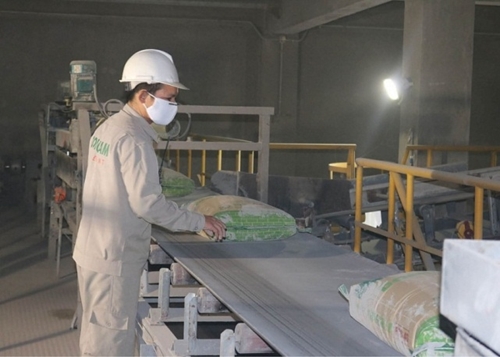Of the total, export volume was 27.23 million tons, up 12 percent thanks to buying rebound seen in many large export outlets such as the U.S., Canada and China, Luong Duc Long, General Secretary of the Vietnam Cement Association (VNCA), said.
    |
 |
|
A production line of cement product. (Photo for illustration) |
Long said demand for cement products in these markets had increased and cement prices there had a tendency to go up.
Meanwhile, domestic consumption saw a modest decline of 5 percent to about 43.54 million tons in the period, according to the association.
Chairman of VNCA Nguyen Quang Cung said the fourth wave of COVID-19 which broke out from the end of April, had suspended construction projects in Hanoi and HCM City and 19 southern localities, resulting in a decline in demand for cement in recent months.
The southern region had the strongest increase in consumption in the country with a year-on-year increase rate of 12.2 percent. Therefore, the prolonged social distancing in this region affected domestic cement consumption significantly, Cung explained.
However, Long said, the vaccination rollout was being accelerated in many localities in order to effectively control the pandemic and gradually relax social distancing to bring daily life back to a new normal.
Therefore, domestic cement consumption was expected to flourish again in later months as the peak construction season began, Long forecast.
According to experts, exports continued to be the growth engine of the cement industry in recent years. They attributed the strong increase in the country's cement exports to the fact that China has gradually closed cement factories, mainly for environmental purposes and increased imports from other countries, especially Vietnam.
In the second quarter alone, China was the largest importer of Vietnam’s cement and clinker with nearly 10.3 million tons, worth 368.6 million USD, accounting for 49.4 percent of total export volume and 45.6 percent of total turnover. It was followed by the Philippines with 3.85 million tons, worth 176 million USD, and Bangladesh with 1.93 million tons, valued at 65.4 million USD.
Experts said the advantage of sea routes had facilitated Vietnam's exports of cement and clinker to China.
Vietnam is currently the fifth biggest cement manufacturer in the world, after China, India, the US, and Russia. Its cement output has doubled within 10 years, from 45.5 million tons in 2009 to about 100 million tons, turning the country from a cement and clinker importer to the world’s largest exporter of these commodities.
Last year, the country shipped 101.5 million tons of these products to overseas markets, representing a rise of 1.5 percent over 2019.
However, in order to maintain exports, cement producers should apply advanced technologies in production to enhance quality and added value while reducing environmental harm, which would significantly help boost competitiveness, experts suggested.
They should also monitor the cement market and adjust their production plans accordingly to keep prices from falling. In addition, cement firms should also work out long-term development strategies.
Source: VNA